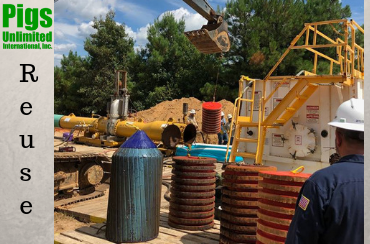Operators will often ask the distance that they might expect to get from their pigging products in terms of miles or kilometers. This question is impossible to answer as it depends on too many variables from line to line, and from one pig manufacturer to the other. Conditions such as the number and degree of bends, the dryness or viscosity of the fluid medium used as a propellant, the density of the pig, the speed at which the pig travels (a pig that moves too slow, below 2fps, may experience stops and starts and “speed excursions”, and will wear down faster than a steady moving pig), the kinds of debris it contacts and the percentage of oversize of the pig OD in relation to the pipeline ID.
Below are some general guidelines that can help an operator determine the remaining life of the pig and help him judge if it is OK to run again:
- On foam pigs, is the urethane skin still adhered to the foam body of the pig? Is there significant cuts or tears that have penetrated through? If the skin appears to be in good shape, it will probably run again. If it begins to separate from the pig, there is a risk that this segment may pull back further, in the worst cases resulting in the foam arriving separate in the receiver from the skin. If using urethane pigs and/or cups and discs, check for gouges in the sealing surfaces (the part that contacts the pipewall during operation) to ensure a proper seal is maintained.
- On brush pigs, inspect the bristles. Is the wear to the bristle significant enough after previous runs to indicate that they may become completely worn before completing another run? If so, another pig should be used, however, if a pig is run 20 miles and it only experiences a 10 percent loss in bristles length, it is reasonable to assume that it will lose approximately the same amount on subsequent runs, and should therefore be acceptable to run several times, provided other factors such as the skin bonding are considered.
- PIG OD – On foam as well as urethane pigs, cups and discs, a special measuring tape known as a diameter tape can be used to wrap around the body of the pig. This will measure the remaining OD of the object. All pigs, cups and discs are larger than the pipeline that they are intended to clean. Foam pigs will elongate, and eventually lose some OD to wear, and urethane cups and discs will wear down from friction, reducing their OD. As long as the OD remains larger than the pipeline it is intended to clean, creating a 360 degree seal around the pipe, the pig will travel and clean, and can therefore be reused. If the amount of oversize is less than 1 percent, special consideration should be given to long runs (in excess of 40-50 miles) so that the seal is not lost, especially on urethane pigs.
- Chemical Exposure, UV Light and ageing can damage pigs. A pig run through a chemical line and then sat on a shelf may appear to be sound, but the cell structure can be damaged and brittle, and the pig may fall apart under pressure in the line. If the operator can with his fingernail pry loose pieces of foam, pig skin, or urethane from cups and discs, the pig should be disposed of. Pigs stored properly and unused may sit in some cases for up to 5 years and still be acceptable for use. Most pigs are stored in moderate conditions, and a good rule of thumb for warehoused pigs that are wrapped and protected from the sun and weather is 2 years.
- Inspect all bolts, usually on a steel pig, after runs, to ensure that they are still snug and ready for the next run. Always use nylocks and other locking fasteners that have protection from the extreme vibrations that pipelines create on a pig when they are traveling through. Loc-tight and other chemical thread sealants are often necessary too.
- Operators may see more wear in the 6 o’clock position, especially on heavier steel pigs. This is due to gravity, the weight of the pig putting the most pressure and friction in this region, and the “bulldozer” effect that pushing from behind creates. A foam pig that is out of round will compress and reassume the shape of the object it is compressed inside of, however solid cast pigs may not reform a perfect seal as easily if this uneven wear is exaggerated. Care should be used to insert the pig in opposite o’clock positions to spread this wear more evenly.
There is lots of data that exists on the run life of pigs. This data varies so much depending on the testing method, the raw materials of construction, especially the chemistry in foam pigs, and line variables, that no operator should rely totally on the case studies or rules of thumb. They provide a good starting point for considering job needs, but in the field real world circumstance and observation should dictate the exact pigging procedure, type, style and number of pigs used, and for how long or how many runs. Usually a pig that is sized correctly can expect to survive many dozens of miles at a minimum, and there are many cases in which pigs have traveled over 100 miles consecutively between launchers and receivers.
Recent smart pig runs have metal pig inspection trains that are often over 10 feet long traveling through and inspecting continuously, lines that run between countries, sometimes for many days in a row without stopping across hundreds of miles. This was accomplished using industry standard urethanes on the driving/sealing elements.
Dec 27, 2018

